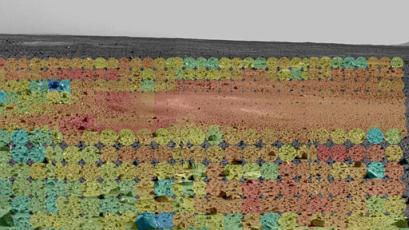Avi Blizovsky

The surface of Mars in the Spirit landing area in Gosev Crater - in the infrared eyes of one of the Spirit devices
Direct link to this page: https://www.hayadan.org.il/spirit090104.html
The Spirit robot stretched the axles of its wheels, stood on the landing pad and photographed its surroundings with infrared vision for the first time since it arrived on Mars about a week ago.
Problems in clearing the airbag from the landing ramp delay the possibility of rolling the robot to the Martian soil for at least a week, but the Spirit is not disabled. As he waits on the lander that brought him to Hamadi, his technology searches for signs of minerals that might have formed in the ancient lake that scientists believe once covered the landing site.
The first signs of the geological cover of Spirit's landing environment could support the theory that flowing water covered the planet's surface during its ancient past and provided a life-supporting environment.
The scientists say that finding minerals, called carbonates, does not immediately mean support for the lake theory. Instead, carbonate dust could have formed by interacting with the small amounts of water evaporating into the Martian atmosphere.
"We have a variety of opinions and ideas and we don't know which one is the right one," says Stephen Squires of Cornell University, the chief scientist of the mission. Previous NASA spacecraft have detected carbonates from space before.
When the Spirit can leave the lander, it will use an alternate route. Engineers have failed to remove an airbag blocking the most promising route to Martian soil. Spirit will now turn 120 degrees to the right and descend a second but more dangerous ramp to the ground. said mission manager Matt Wallace.
While parked, Spirit finished taking a panoramic photo of her surroundings with her color camera. NASA has received most of the hallucinations from the 360-degree mirror and is expected to receive the rest in batches over the next few days, said the project's deputy director, Albert Heldman.
Spirit also began measuring the temperature and structure of the surrounding rocks and soil using a spectrometer that examines small-scale heat emissions. "The device actually sees infrared radiation - heat - emitted by objects, including rocks and soil. Changes in the radiation that Spirit sees make it possible to learn what types of rocks are around and which ones are the most worthwhile to analyze.
On Friday, scientists showed the first set of data showing psychedelic-colored mirrors of the Martian surface. Warm covers of sand glow red and relatively cold rocks appear in deep blue.
Update 11 / 1 / 04
The "Spirit" measured the temperature on Mars
Voila system!
The American space vehicle "Spirit" that landed on Mars, measured the temperature at the place of its landing on the planet. The findings show that the highest temperature in the landing area is 5 degrees Celsius. Kol Israel reported that the lowest temperature is 15 degrees Celsius below zero.
עדכון:9/1/04 15:00
The spirit will have to wait a little longer on the pedestal
NASA says that the Spirit will have to wait a little longer on the landing pad, before it can deploy its wheels and drive it for a tour of Mars.
The scientists discovered some technical problems. One of them is an airbag that blocks his descent from the pedestal, but they do not attach any special importance to this problem, and they believe that it can be solved.
Another small problem is a kind of "hiccup" of the antenna, in which the fear is that data will be lost on the way to Earth.
The Martian vehicle got stuck due to an airbag
NASA scientists have so far failed in their attempts to move "Spirit" stuck in the air bags that stopped its fall. Even without movement, the vehicle began its work. The European "Beagle" still has no trace
Voila system!
NASA's propelled space vehicle on the planet Mars had difficulty moving yesterday because the air bags, designed to stop its fall to the planet, blocked its path. So far, the efforts of the scientists of the American space agency to return the "Spirit" to movement in the crater it is supposed to scan have failed.
The scientists intend to soon try again to move the airbags using the vehicle's robotic arm. "We failed to do that yesterday," said Matt Wallace, the mission's director. Another option being considered is directing the vehicle downhill in a different direction, by turning it 120 degrees to the right or 60 degrees to the left - an action that could jeopardize the mission that costs 820 million dollars.
Even while still positioned on its landing pad, the Spirit began performing scientific work involving taking high-resolution images of its surroundings. The vehicle will soon transmit to the earth a complete panorama of the area around it. A first examination of the images sent by the space vehicle revealed that the soil of the crater where it landed is not similar in nature to what the scientists had planned and therefore the task is expected to be more difficult.
It was reported in the AP agency that the "twin" of the Spirit, "Opportunity", is supposed to join it in the mission on the other side of the equatorial equator on January 24, if it lands safely.
Towards the end of December, the European space vehicle "Beagle" landed on the planet's soil on a mission to explore its surface, but since then the scientists have not been able to make contact with it and its location is unknown. Several attempts to locate the spacecraft have so far failed.
All updates are of course in Mars science - current missions
For news on the subject in CNN
For news on Yahoo's news site
https://www.hayadan.org.il/BuildaGate4/general2/data_card.php?Cat=~~~733214562~~~16&SiteName=hayadan
